The enduring appeal of Transport for London’s seat designs
From artist Rita Keegan’s new collage to fashion designer Adam Jones’ Overground suit, TfL moquettes continue to enjoy a cult status
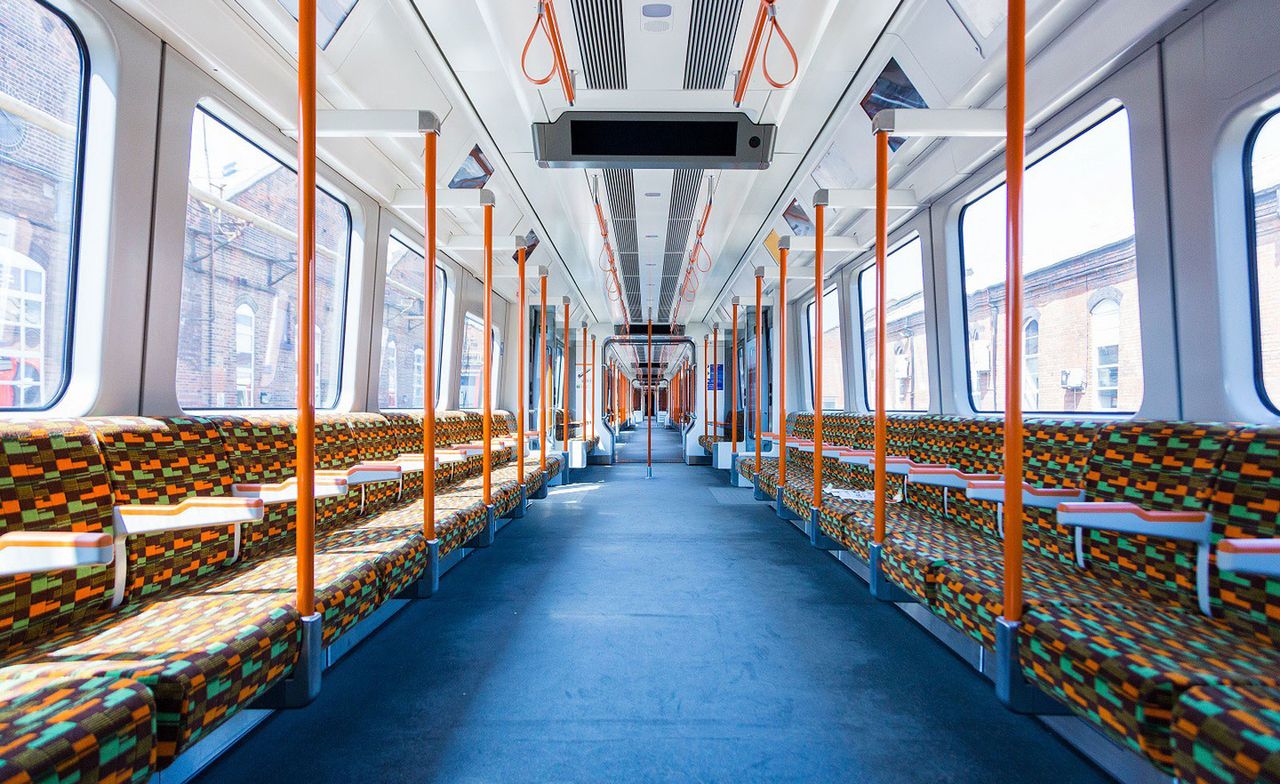
This year, Transport for London – or TfL – turns 25. Some commuters probably feel like they have aged double that in the same stretch of time. It might have given us the Oyster card, the Hopper fare and the Lizzy Line, but it’s not always been plain railing on the transport network of Europe’s most congested city. Especially when you’re inhaling a miasma of metallic particles and enduring ear-perforating, gear-grinding screeching every morning.
Something, though, continues to delight art anoraks whenever we board or alight a bus, train or Tube in London: the designs of the seats. As true trainspotters will know, the thick fabric used for transport upholstery is termed moquette – an old French word for carpet. It’s traditionally crafted from 85 per cent wool mixed with 15 per cent nylon, using a Jacquard loom to create intricate patterns.
The earliest moquette commissioned for the capital’s trains was an archetypal art deco design from Firth Furnishings Limited (whimsically titled ‘Lozenge’) woven in brown, fawn and blue. Then, when London Transport (as it was then) was formed in the 1930s, artists and designers got on board, collaborating with the manufacturers to create distinctive motifs; the likes of Marianne Straub, Douglas Scott and Enid Marx have all worked on their own versions over the decades.
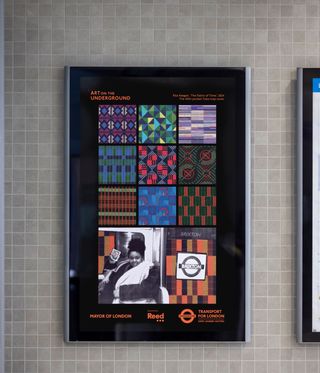
A collage by artist Rita Keegan, who has designed the 40th pocket Tube map cover
More recently, in 2008, TfL commissioned textile design duo Wallace Sewell for the first time. The result was the 2008 Overground moquette, criss-crossing midcentury browns and oranges to exude a distinctly 1970s earthiness. Later, the pair worked on ‘Barman’ (the instantly recognisable blue Victoria Line design turning London landmarks into abstract primary shapes) and the simply labelled ‘Elizabeth Line Moquette’ (a purple pinstripe pattern used to create a sense of speed).
Increasingly, though, moquette is jumping out of our seats. In February 2025, TfL launched its Fabric of London campaign, showcased on Outernet London’s gigantic LED screens. Inspired by seating fabric patterns of the past, it features an immersive digital moquette and animations of a diverse array of Londoners, reflecting the city’s rich cultural tapestry.
It follows The Fabric of Time, a new collage by artist Rita Keegan featured on the 40th pocket Tube map cover. Drawing on Keegan's research into female moquette designers of the past, it constructs a grid from ten archive seat designs. ‘I was spoilt for choice but there were certain ones that appealed to my design sensibilities,’ she says. Superimposed is an old photo of the artist in her thirties at Brixton station. Look closer, and you notice that Keegan is, impossibly, holding a recent selfie of her current self, aged 76; a fleeting blur of past and present.
TfL seems to be cashing in on this newfound cultural cachet. Last November, the local government authority partnered with Sony to install a Playstation-inspired moquette on the Victoria Line, complete with ‘Start’ and ‘Finish’ emblems. Back in 2022, Arsenal launched a pre-match kit inspired by the Piccadilly Line.
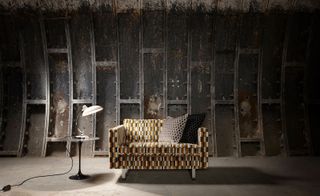
A moquette sofa
The world of fashion is also alight with moquette inspiration. Welsh designer Adam Jones, known for his bar-towel sweaters and quintessentially British references, recently used the Overground design for a red carpet look. ‘Jack Rooke (creator of comedy Big Boys) came to me with an idea of making a suit for him for the BAFTAs using the pattern, so I made one using the mohair blankets from the TfL museum shop,’ Jones says, hinting that he’s going to go further for his upcoming collection.
Previously, Nike revived Misha Black's 1978 moquette for a limited-edition pair of trainers in 2013, and streetwear brand Done emblazoned the Victoria Line motif on a range of jackets in 2022. And while there’s no concrete evidence of inspiration, Gucci’s illusionary geometric prints and Burberry’s reimagined checks of the past few years aren’t a million miles away from moquette.
It’s not just London leading the charge. See the incredibly popular I Don't Give a Seat, an Instagram account created by French director Julien Potart followed by 145,000 enthusiasts, featuring retro transport seat patterns from across the world: recent highlights include a trippy digital camo from Düsseldorf, a contour line motif from Angers and a puzzle piece design from Bontida.
But what makes moquette such a worthy muse for artists and designers? To some Tube seat critics, the garish geometric aesthetic makes for hideous viewing. They are, after all, purposefully clashing to mask all sorts of stains left by careless commuters. For enthusiasts, though, the seats are a sight for sore eyes; they are charmingly kitsch and refreshingly loud in a world of muted minimalism. ‘It's like when you're on a train, you experience a rhythm. It's a beautiful design, simple but complex,’ Keegan says of Joy Jarvis’ 1947 ‘Roundel’ pattern, featured in Fabric of Time.
For designers, the fabric, too, is a joy. It’s velvety, durable and insulates well. And it’s almost entirely natural, with only a little nylon added for resilience to help the seats withstand wear-and-tear. No wonder you can buy it by the metre online, ideal for a keen upcycler or upholsterer with their own tunnel vision (the TfL shop also regularly runs out of socks, scarves and ties).
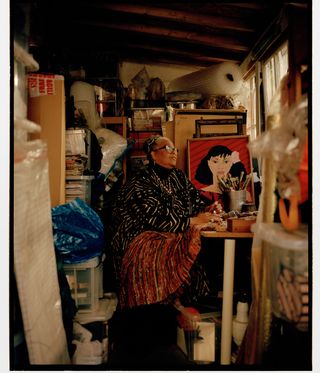
Artist Rita Keegan
Most interesting, though, are the stories stitched into every thread; woven into every design is an experience of London. ‘It's full of history, especially as it’s no longer used,’ Jones says of the archive District Line design. ‘I love to think about who might have sat on that pattern and what they were doing or where they were going; it ties into this nostalgia I have for the past and the 1970s in particular.’
Seen this way, moquette is a gateway to the past, a shared heirloom transporting us back to liminal moments spent on the Tube, weaving together our experiences. ‘It's about the connection to London. It’s our journey. You work, rest and play. Living in a metropolis means you take advantage of that. You're going out, you're going to work and you're coming back [on the train], so it's linked with the textures of life,’ Keegan says.
Ultimately, the moquettes are an exemplary fusion of form and function. ‘They were designed for a specific purpose and they actually fulfilled it. I love them. They're fabulous. You want your journey to take you somewhere and the moquette designs do,’ Keegan says.
And with the trend cycle ever-revolving and constantly reinventing imagery of the past, we can expect more artists to take our seats and turn them into masterpieces in the very near future. Last year’s coquette aesthetic is, perhaps, ready to change into the moquette aesthetic.
The London Transport Museum shop sells moquette furniture and cushions, ltmuseumshop.co.uk/furniture
Wallpaper* Newsletter
Receive our daily digest of inspiration, escapism and design stories from around the world direct to your inbox.
Kyle MacNeill is a freelance arts writer who contributes to publications including The Guardian, Financial Times and New York Times. He is interested in the study of objects, niche communities and fakeness.
-
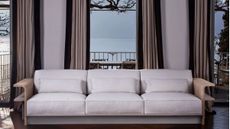 Promemoria’s new furniture takes you from London to Lake Como, with love
Promemoria’s new furniture takes you from London to Lake Como, with loveAhead of its Milan Design Week 2025 debut, we try out Promemoria’s new furniture collection by David Collins Studio, at founder Romeo Sozzi’s Lake Como villa
By Laura May Todd Published
-
 Fluid workspaces: is the era of prescriptive office design over?
Fluid workspaces: is the era of prescriptive office design over?We discuss evolving workspaces and track the shape-shifting interiors of the 21st century. If options are what we’re after in office design, it looks like we’ve got them
By Ellie Stathaki Published
-
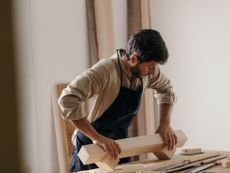 This collection of slow furniture is a powerful ode to time
This collection of slow furniture is a powerful ode to timeA serene exhibition of David Dolcini's 'Time-made' collection has fast-tracked its place into our hearts and homes
By Ifeoluwa Adedeji Published
-
 A major Frida Kahlo exhibition is coming to the Tate Modern next year
A major Frida Kahlo exhibition is coming to the Tate Modern next yearTate’s 2026 programme includes 'Frida: The Making of an Icon', which will trace the professional and personal life of countercultural figurehead Frida Kahlo
By Anna Solomon Published
-
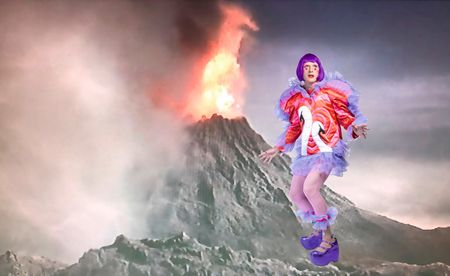 A portrait of the artist: Sotheby’s puts Grayson Perry in the spotlight
A portrait of the artist: Sotheby’s puts Grayson Perry in the spotlightFor more than a decade, photographer Richard Ansett has made Grayson Perry his muse. Now Sotheby’s is staging a selling exhibition of their work
By Hannah Silver Published
-
 Celia Paul's colony of ghostly apparitions haunts Victoria Miro
Celia Paul's colony of ghostly apparitions haunts Victoria MiroEerie and elegiac new London exhibition ‘Celia Paul: Colony of Ghosts’ is on show at Victoria Miro until 17 April
By Hannah Hutchings-Georgiou Published
-
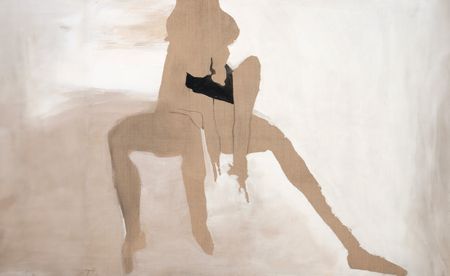 Teresa Pągowska's dreamy interpretations of the female form are in London for the first time
Teresa Pągowska's dreamy interpretations of the female form are in London for the first time‘Shadow Self’ in Thaddaeus Ropac’s 18th-century townhouse gallery in London, presents the first UK solo exhibition of Pągowska’s work
By Sofia Hallström Published
-
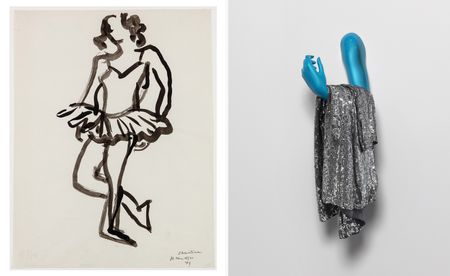 Sylvie Fleury's work in dialogue with Matisse makes for a provocative exploration of the female form
Sylvie Fleury's work in dialogue with Matisse makes for a provocative exploration of the female form'Drawing on Matisse, An Exhibition by Sylvie Fleury’ is on show until 2 May at Luxembourg + Co
By Hannah Silver Published
-
 What to see at BFI Flare film festival, 'a rich tapestry of queer experience'
What to see at BFI Flare film festival, 'a rich tapestry of queer experience'As one of the only film festivals to explicitly profile LGBTQI+ cinema, BFI Flare Film Festival remains a unique and beloved event. Here's what to see as it makes its return to London from 19 - 30 March
By Billie Walker Published
-
 ‘There's a lot to fear and a lot to love in this world’: Penny Goring unveils new work in London
‘There's a lot to fear and a lot to love in this world’: Penny Goring unveils new work in LondonA new collection of large-scale collages takes centre stage at 'Penny Goring: Cold Hunt Corsage' at Arcadia Missa, London
By Hannah Silver Published
-
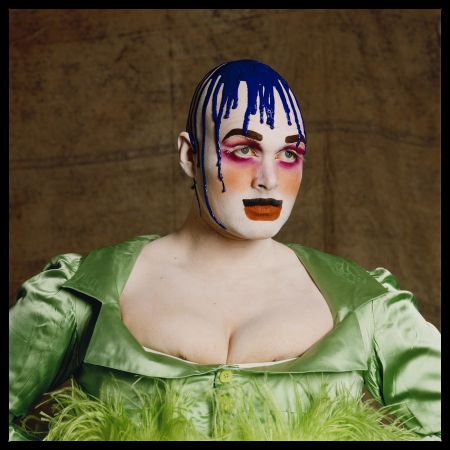 ‘Leigh Bowery!’ at Tate Modern: 1980s alt-glamour, club culture and rebellion
‘Leigh Bowery!’ at Tate Modern: 1980s alt-glamour, club culture and rebellionThe new Leigh Bowery exhibition in London is a dazzling, sequin-drenched look back at the 1980s, through the life of one of its brightest stars
By Amah-Rose Abrams Published